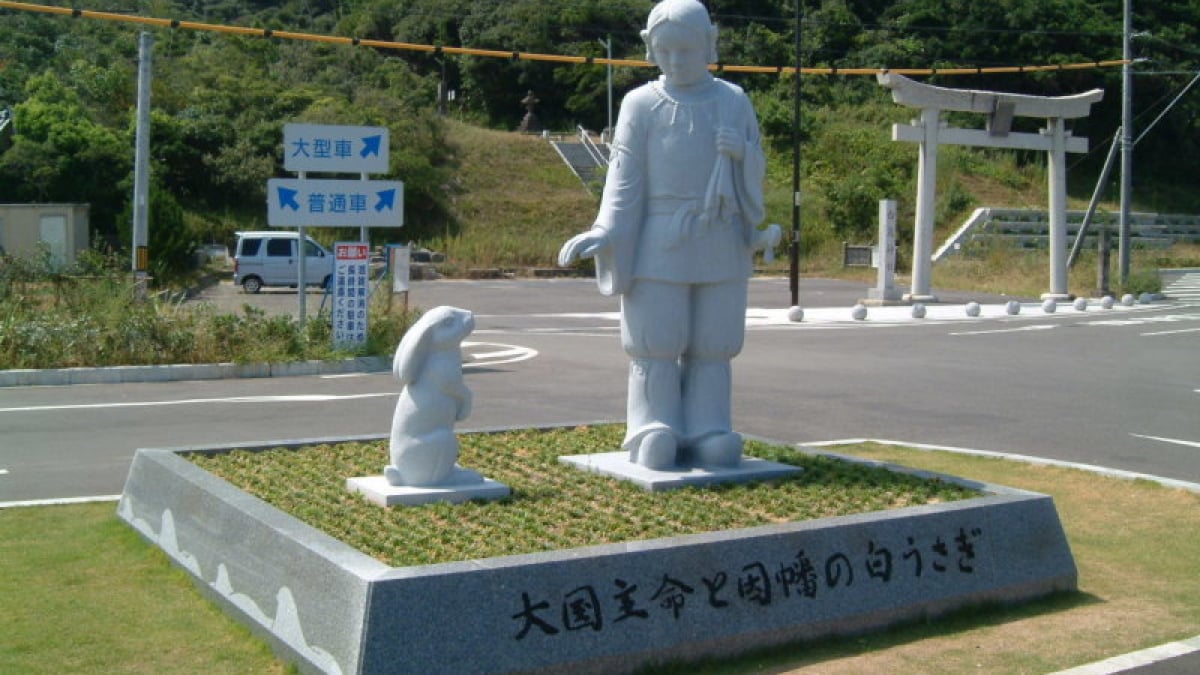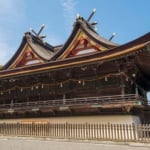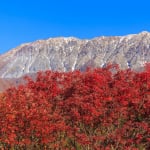Name: Hakuto Shrine
Address: 603 Hakuto Miyagoshi, Tottori City, Tottori Prefecture
Official Website: http://www.tottori-guide.jp/tourism/tour/view/21

5 Spiritual Power Spots in Tottori Linked to the Legend of the White Rabbit of Inaba! Boost Your Luck in Wealth and Longevity
Tottori is home to the famous "Legend of the White Rabbit of Inaba." One of the most well-known scenes from this myth depicts the white rabbit counting the backs of sharks while crossing the sea before declaring, "I tricked you!"—only to have its skin stripped off by the sharks in revenge.
Among the various spiritual power spots in Tottori, the Hakuto Shrine, closely linked to this legend, is a significant place to visit.
Additionally, Tottori features many power spots rooted in history and tradition. The Ichinomiya Shrine of Inaba enshrines Takenouchi no Sukune, the oldest vassal who once assisted an ancient emperor, making it a site known for longevity and child-rearing blessings. There’s also Kanemochi Shrine, associated with the ancient iron-making techniques using iron sand, which symbolizes prosperity and wealth. The Shitori Shrine, dedicated to Tatebaha-tsuchi no Mikoto, the god of weaving, reflects the historical legacy of industries and craftsmanship in the region.
Here, we introduce five must-visit power spots in Tottori, where ancient legends and modern spiritual energy come together. Use this guide to help plan your visit!
table of contents
[x] close
5 Spiritual Power Spots in Tottori Linked to the Legend of the White Rabbit of Inaba! Boost Your Luck in Wealth and Longevity
- 1. Hakuto Shrine – The Place Where the White Rabbit of Inaba Washed Its Body
- 2. Ube Shrine – The Ichinomiya of Inaba Province
- 3. Kanemochi Shrine – The Land of Wealth and Fortune
- 4. Ōgamiyama Shrine – A Sacred Site for Japanese Culture
- 5. Shitori Shrine – The Shrine of Weaving and Safe Childbirth
- ◎ Summary
1. Hakuto Shrine – The Place Where the White Rabbit of Inaba Washed Its Body
Hakuto Shrine is one of the most famous power spots in Tottori, deeply connected to the Legend of the White Rabbit of Inaba, the region's most well-known myth. According to the Kojiki (Japan’s oldest historical record), the god Ōnamuji no Kami (also known as Ōkuninushi no Kami) was able to rule the land because he saved the white rabbit.
The story tells how the rabbit was skinned by sharks after tricking them, and then suffered further when it was incorrectly advised to dry itself with seawater. Ōnamuji no Kami taught the rabbit the proper treatment, allowing it to heal. In gratitude, the white rabbit helped him gain dominion over the land.
Due to this legend, Hakuto Shrine, which enshrines Hakuto Okami, has long been a place of worship for healing skin diseases and is considered a shrine of medicine and health.
In the past, the shrine was located near the sea, and it is said that medicinal plants used for treatment once grew abundantly in the area. Fuzō Fugen Pond, a sacred body of water whose water levels remain constant regardless of the weather, is considered the exact place where the white rabbit washed its body. The shrine is also known as a power spot for relationships and matchmaking.
2. Ube Shrine – The Ichinomiya of Inaba Province
Believed to have been founded in 648 during the reign of Emperor Kōtoku, Ube Shrine is the Ichinomiya (highest-ranked shrine) of Inaba Province. It enshrines Takenouchi no Sukune no Mikoto, Japan’s oldest vassal, who served and assisted five emperors: Emperor Keikō, Seimu, Chūai, Ōjin, and Nintoku. Recognized for his exceptional loyalty, he was granted the title of Minister of State and played a significant role in shaping Japan. He is revered as a god of longevity.
Takenouchi no Sukune was also an advocate for adopting foreign culture and technology. Due to his deep involvement in protecting and raising imperial children, he is also worshipped as a deity of child-rearing.
The shrine’s current structure was rebuilt in 1898, and it was so significant that it was featured on the design of Japan’s 1-yen and 5-yen banknotes during the Meiji and Taishō periods. The Kirin Lion Dance, performed during the spring festival where a giant portable shrine is carried up the hill, has been designated as an intangible cultural heritage of Tottori Prefecture.
Name: Ube Shrine
Address: 651 Miyashita, Kokufu-cho, Tottori City, Tottori Prefecture
Official Website: http://www.ubejinja.or.jp/index.php
3. Kanemochi Shrine – The Land of Wealth and Fortune
Kanemochi Shrine (pronounced Kamochi Jinja) is a rare power spot in Japan that enshrines Ame-no-Tokotachi-no-Mikoto, a deity that celebrates the greatness of the heavens. According to legend, the shrine was founded in 810 when the son of an Izumo priest received divine guidance while traveling to Ise Shrine.
The area around the shrine was historically rich in iron sand, a key resource for producing Tamahagane (traditional Japanese steel used for sword-making). During ancient times, iron was more valuable than gold, and because iron was often referred to as “gold”, the area became known as "Kanemochi" (literally meaning “wealthy”).
The surname “Kanemochi” also traces its origins to this region. With such a lucky name, the shrine has become a popular spot for praying for lottery success and financial prosperity, with many visitors returning to express gratitude after winning.
Visit Kanemochi Shrine, one of Japan’s top wealth-enhancing power spots, and boost your financial luck!
Name: Kanemochi Shrine
Address: 74 Kanemochi, Hino Town, Hino District, Tottori Prefecture
Official Website: http://kanemochi-jinja.net/
4. Ōgamiyama Shrine – A Sacred Site for Japanese Culture
Ōgamiyama Shrine is a famous power spot known for its 700-meter-long stone-paved approach, which is the longest stone-paved shrine path in Japan. The shrine is situated on Ōgamiyama (also called Daisen), a 1,729-meter volcanic peak, making it the highest mountain in the Chūgoku region.
Daisen has been a center for mountain worship for over 1,000 years and served as a training ground for Shugendō (a form of ascetic Buddhism). The shrine’s origins date back to a simple worship site at 900 meters above sea level, where the mountain itself was revered as a sacred deity.
During the Kamakura period (1333), Emperor Go-Daigo, who had escaped exile from Oki Island, is said to have prayed at this shrine for the overthrow of the Kamakura Shogunate.
The belief that mountains themselves are divine is deeply rooted in Japan’s ancient Shinto traditions. Over time, Shintoism, Shugendō, and Buddhism blended together, shaping Japan’s spiritual and cultural identity. Ōgamiyama Shrine is one of Japan’s most historic and powerful spiritual sites.
Name: Ōgamiyama Shrine
Address: 9 Daisen, Daisen Town, Saihaku District, Tottori Prefecture
Official Website: http://www.oogamiyama.or.jp/
5. Shitori Shrine – The Shrine of Weaving and Safe Childbirth
Located in Hōki Province, Shitori Shrine (Shidori Jinja) is a power spot dedicated to Tatebaha-tsuchi no Mikoto and Shitateru-hime no Mikoto. Tatebaha-tsuchi no Mikoto is the god of weaving, worshipped by the Shitori clan, who were skilled in traditional textile production. Shitateru-hime, a female deity, is sometimes said to represent Queen Himiko, the legendary ruler of ancient Japan.
As a goddess, she is also worshipped as a protector of safe childbirth. There is a legend that drinking water from a sacred rock called "Anzan Iwa" (Safe Childbirth Rock) can help ensure a smooth delivery.
If you are expecting a child or planning for a family, consider visiting Shitori Shrine to pray for a safe childbirth and a prosperous future.
Name: Shitori Shrine
Address: Miyauchi, Yurihama Town, Tōhaku District, Tottori Prefecture
Official Website: http://www.tottori-guide.jp/tourism/tour/view/338
◎ Summary
The White Rabbit of Inaba was healed after learning the correct treatment method from the gods, rather than using seawater. This ancient wisdom of healing through natural remedies contributed to the reverence for medical deities in Japan.
Tottori is home to many shrines associated with ancient knowledge and foreign influences—from Takenouchi no Sukune, who introduced continental knowledge, to Kanemochi Shrine, symbolizing the iron-making culture, and Shitori Shrine, dedicated to textile craftsmanship.
Tottori preserves a blend of foreign influences, ancient mountain worship, and traditional Japanese beliefs. Visit these powerful spiritual sites to recharge your energy and experience Japan’s rich history firsthand!
RELATED ARTICLES
REGIONS
CATEGORIES
FEATURED ON tottori
-

5 Recommended Tourist Spots in Sakaiminato City — The Town Where Kitaro Lives is Full of Fun!
-

6 Recommended Tourist Attractions in Tottori City, Tottori Prefecture! A City of Sand and History Representing the San’in Region
-

[Hyogo/Shin Onsen Town] Shiwagara Falls | Overwhelmed by a Mystical Waterfall! Also Introducing Nearby Tourist Spots
-

[4-day holiday in the Chugoku region] Summary of summer outing spots ◎ Enjoy the great outdoors!
-

[Tottori Prefecture] Kakikake Pass Sightseeing Information! Experience the Breathtaking Autumn Foliage of Mount Daisen and Rural Spots
MOST POPULAR ON tottori
-
 1
1Doha: Must-see Attractions in the Capital of Qatar
-
 2
2Toronto: 10 Things to do in this Picturesque Canadian City
-
 3
3Amarillo: A City Famous for It’s Amazing Canyons, Great History and Music
-
 4
4South Korea: Dazzling Scenery, Rich Culture and Fascinating History
-
 5
5Kuwait: A Country in Middle East Asia Famous for Hot Sand Dunes and Stunning Cityscape





